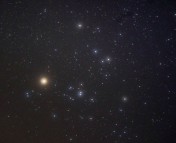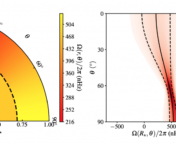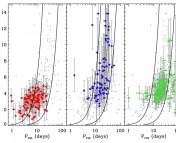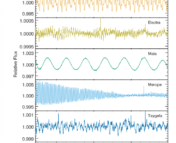Title: Weakened magnetic braking supported by asteroseismic rotation rates of Kepler dwarfs
Authors: Oliver J. Hall, Guy R. Davies, Jennifer van Saders, Martin B. Nielsen, Mikkel N. Lund, William J. Chaplin, Rafael A. Garcìa, Louis Amard, Angela A. Briemann, Saniya Khan, Victor See, Jamie Tayar
First Author’s Institution: European Space Research and Technology Centre (ESTEC)
Status: Published in Nature Astronomy [closed access]
Do you remember watching figure skaters at the Olympics and marveling at how fast they were spinning? And how when they pulled their legs closer to their body, they’d start spinning faster and faster? This textbook example of angular momentum is not only exciting to watch at the Olympics, but is also one of the ways in which astronomers determine the ages of stars.
Spinning Out of Control
Stars are born in hot, rotating disks composed of gas originating from the interstellar medium. The buildup of gas in the center of the disk is called the protostar which transforms into a star when the density and temperature are high enough to begin fusion. Once born, the star begins its life on the main-sequence spinning continuously. Over time, the magnetic field around the star affects the stellar wind which causes the star to spin down; this phenomenon is called “magnetic braking” given the role of the magnetic field. As a result, the star experiences mass loss which slows its rotation. Therefore, we can use the correlation between a star’s spin and lifetime to determine its age.

Gyrochronology is the study of the relationship between stellar rotation and age (check out this bite for an in-depth explanation). When stars are born, they have higher angular momentum and faster spin (or lower rotation periods). As they age, they reach slower spins (or higher rotation periods) because of a loss in angular momentum. Therefore, a star’s age can be determined by measuring its rotation period.
van Saders+2016 (summary of paper) found that some older stars were rotating faster than they should according to stellar models, and suggested Weakened Magnetic Braking (WMB) as a reason for this discrepancy (see Figure 1). They concluded that at some stage during a star’s lifetime, the star undergoes weakened magnetic braking where the efficiency of angular momentum loss – the mechanism that causes stars to spin down – drops drastically, which results in a faster than normal rotation period for older stars.
While a plausible theory, it can be argued that this phenomenon is due to an observational bias. Since a rotation period is measured using sun-spots on the stellar surface, and stellar activity decreases as the star ages, there is a lack of older stars with a measured rotation period. To resolve this debate, the authors of today’s paper carried out a systematic measurement of stellar rotation periods without relying on sun-spots, and analyzed the likelihood of a star belonging to a stellar model that includes weakened magnetic braking.
Making Waves
How else can one measure stellar spin? Asteroseismology – the study of stellar oscillations – is a powerful tool to measure stellar rotation periods (check out previous posts here and here for more on this technique). Briefly, sound waves bouncing in the stellar interior are observable as a change in brightness over time. By converting the time-series observations of brightness fluctuations to the frequency domain, we can pick out the frequencies at which the star is oscillating, which we call ‘oscillation modes’. For a rotating star, certain oscillation modes shift to higher or lower frequencies, as compared to a non-rotating star. This is called rotation splitting and is an accurate tool for calculating rotation periods (check out this bite for an example of this being done).
Step-By-Step
As a first step, the authors of today’s paper validated the accuracy of rotation splitting by comparing rotation periods measured using both sun-spots and asteroseismology; they found a 96% agreement between the distribution of both sets. Next, to test the likelihood of a standard stellar evolutionary model against one that includes WMB, they assembled a sample of 91 main sequence stars (of which 4 may have started to evolve into subgiants) spanning ages between 1-13 billion years. While the input physics was the same for both models, they applied an additional condition to the WMB model. This property is inversely proportional to stellar activity (thus positively proportional to stellar age), and is therefore an appropriate parameter to include in this study.
Finally, to carry out their analysis, the authors compared rotation rates for their sample to a synthetic population of stars likely to be discovered by Kepler. Then, they used a Bayesian mixture model to evaluate the likelihood of a star belonging to either of the two theories, similar to drawing names out of a hat to see if a piece of paper is most likely to read ‘weakened magnetic braking’ or ‘observational bias’.
Braking it Down
They found that their collection of stars was 98.4% more likely to be drawn from a rotation evolution model that includes weakened magnetic braking rather than a standard model. Given this significant result in support of the WMB model, they re-tested their analysis by incorporating uncertainties, overestimating their seismic stellar ages, and reducing their sample to include low quality data. Despite all the alterations, they still recovered a high correlation between rotation periods and the weakened magnetic braking model.
Now that the theory of weakened magnetic braking has been shown to be extremely likely, the question evolves into ‘how does this happen?’. There is still future work to be done – such as comparing different braking laws or fine-tuning fitting parameters – but authors of this paper successfully showed why gyrochronology is useful and aptly gaining momentum.
Astrobite edited by William Balmer & Sumeet Kulkarni
Featured image credit: MPS / MarkGarlick.com




